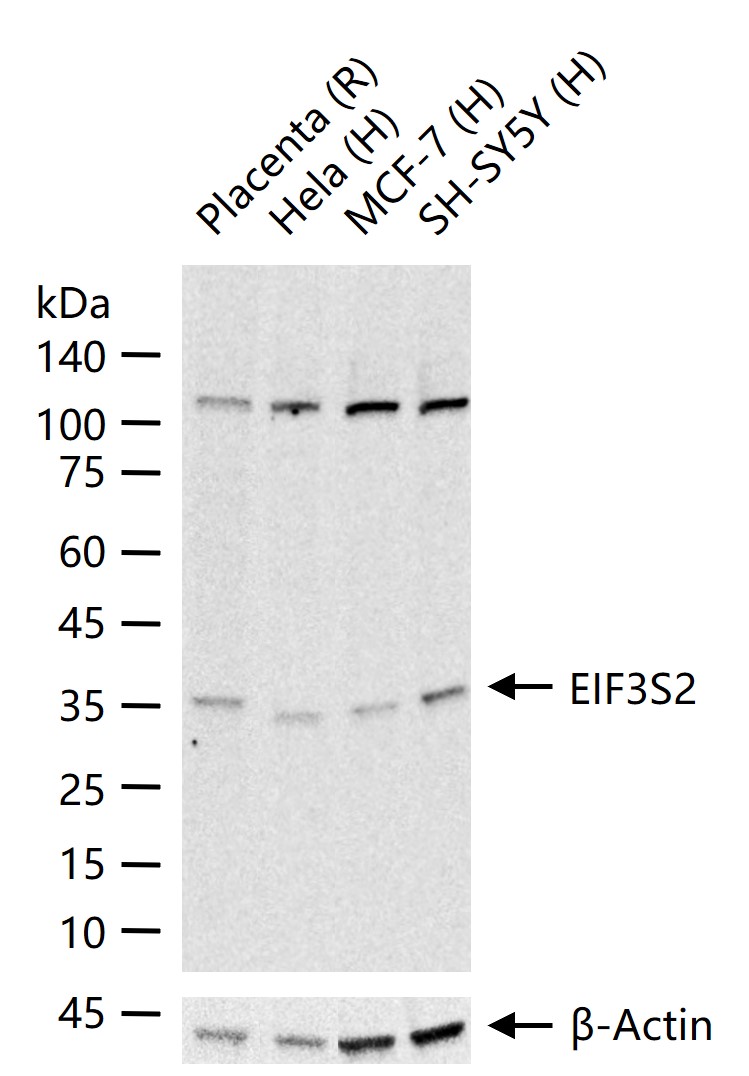EIF3S2 Rabbit pAb
EIF3S2 Rabbit pAb
- 产品详情
- 实验流程
- 背景知识
Application
| WB, IHC-P, IHC-F, IF |
|---|---|
| Primary Accession | Q13347 |
| Reactivity | Pig, Human, Dog |
| Host | Rabbit |
| Clonality | Polyclonal |
| Calculated MW | 36502 Da |
| Physical State | Liquid |
| Immunogen | KLH conjugated synthetic peptide derived from human EIF3S2 |
| Epitope Specificity | 161-260/325 |
| Isotype | IgG |
| Purity | affinity purified by Protein A |
| Buffer | 0.01M TBS (pH7.4) with 1% BSA, 0.02% Proclin300 and 50% Glycerol. |
| SUBCELLULAR LOCATION | Cytoplasm. |
| SIMILARITY | Belongs to the eIF-3 subunit I family. Contains 5 WD repeats. |
| Post-translational modifications | Phosphorylated by TGF-beta type II receptor. |
| Important Note | This product as supplied is intended for research use only, not for use in human, therapeutic or diagnostic applications. |
| Background Descriptions | The initiation of protein synthesis in eukaryotic cells is regulated by interactions between protein initiation factors and RNA molecules. Eukaryotic initiation factors (eIFs) are utilized in a sequence of reactions that lead to 80S ribosomal assembly and, ultimately, translation. The eukaryotic initiation factor-3 (eIF3) scaffolding structure is the largest of the eIF complexes and includes eIF3 alpha, eIF3 beta, eIF3 gamma, eIF3 delta, eIF3 epsilon, eIF3 omega, eIF3 eta, all of which function to control the assembly of the 40S ribosomal subunit. Association of eIF3 proteins with the 40S ribosomal subunit stabilizes eIF2-GTP-Met-tRNAiMet complex association and mRNA binding, and promotes dissociation of 80S ribosomes into 40S and 60S subunits, thereby promoting the assembly of the pre-initiation complex. Overexpression of eIF3 proteins is common in several cancers, suggesting a role for eIF3 proteins in tumorigenesis. |
| Gene ID | 8668 |
|---|---|
| Other Names | Eukaryotic translation initiation factor 3 subunit I {ECO:0000255|HAMAP-Rule:MF_03008}, eIF3i {ECO:0000255|HAMAP-Rule:MF_03008}, Eukaryotic translation initiation factor 3 subunit 2 {ECO:0000255|HAMAP-Rule:MF_03008}, TGF-beta receptor-interacting protein 1, TRIP-1, eIF-3-beta {ECO:0000255|HAMAP-Rule:MF_03008}, eIF3 p36 {ECO:0000255|HAMAP-Rule:MF_03008}, EIF3I {ECO:0000255|HAMAP-Rule:MF_03008} |
| Dilution | WB=1:500-2000,IHC-P=1:100-500,IHC-F=1:100-500,IF=1:100-500 |
| Storage | Store at -20 °C for one year. Avoid repeated freeze/thaw cycles. When reconstituted in sterile pH 7.4 0.01M PBS or diluent of antibody the antibody is stable for at least two weeks at 2-4 °C. |
| Name | EIF3I {ECO:0000255|HAMAP-Rule:MF_03008} |
|---|---|
| Function | Component of the eukaryotic translation initiation factor 3 (eIF-3) complex, which is required for several steps in the initiation of protein synthesis (PubMed:17581632, PubMed:25849773, PubMed:27462815). The eIF-3 complex associates with the 40S ribosome and facilitates the recruitment of eIF-1, eIF-1A, eIF-2:GTP:methionyl- tRNAi and eIF-5 to form the 43S pre-initiation complex (43S PIC). The eIF-3 complex stimulates mRNA recruitment to the 43S PIC and scanning of the mRNA for AUG recognition. The eIF-3 complex is also required for disassembly and recycling of post-termination ribosomal complexes and subsequently prevents premature joining of the 40S and 60S ribosomal subunits prior to initiation (PubMed:17581632). The eIF-3 complex specifically targets and initiates translation of a subset of mRNAs involved in cell proliferation, including cell cycling, differentiation and apoptosis, and uses different modes of RNA stem-loop binding to exert either translational activation or repression (PubMed:25849773). |
| Cellular Location | Cytoplasm {ECO:0000255|HAMAP-Rule:MF_03008}. |
For Research Use Only. Not For Use In Diagnostic Procedures.
Provided below are standard protocols that you may find useful for product applications.
BACKGROUND
The initiation of protein synthesis in eukaryotic cells is regulated by interactions between protein initiation factors and RNA molecules. Eukaryotic initiation factors (eIFs) are utilized in a sequence of reactions that lead to 80S ribosomal assembly and, ultimately, translation. The eukaryotic initiation factor-3 (eIF3) scaffolding structure is the largest of the eIF complexes and includes eIF3 alpha, eIF3 beta, eIF3 gamma, eIF3 delta, eIF3 epsilon, eIF3 omega, eIF3 eta, all of which function to control the assembly of the 40S ribosomal subunit. Association of eIF3 proteins with the 40S ribosomal subunit stabilizes eIF2-GTP-Met-tRNAiMet complex association and mRNA binding, and promotes dissociation of 80S ribosomes into 40S and 60S subunits, thereby promoting the assembly of the pre-initiation complex. Overexpression of eIF3 proteins is common in several cancers, suggesting a role for eIF3 proteins in tumorigenesis.
终于等到您。ABCEPTA(百远生物)抗体产品。
点击下方“我要评价 ”按钮提交您的反馈信息,您的反馈和评价是我们最宝贵的财富之一,
我们将在1-3个工作日内处理您的反馈信息。
如有疑问,联系:0512-88856768 tech-china@abcepta.com.























 癌症的基本特征包括细胞增殖、血管生成、迁移、凋亡逃避机制和细胞永生等。找到癌症发生过程中这些通路的关键标记物和对应的抗体用于检测至关重要。
癌症的基本特征包括细胞增殖、血管生成、迁移、凋亡逃避机制和细胞永生等。找到癌症发生过程中这些通路的关键标记物和对应的抗体用于检测至关重要。 为您推荐一个泛素化位点预测神器——泛素化分析工具,可以为您的蛋白的泛素化位点作出预测和评分。
为您推荐一个泛素化位点预测神器——泛素化分析工具,可以为您的蛋白的泛素化位点作出预测和评分。 细胞自噬受体图形绘图工具为你的蛋白的细胞受体结合位点作出预测和评分,识别结合到自噬通路中的蛋白是非常重要的,便于让我们理解自噬在正常生理、病理过程中的作用,如发育、细胞分化、神经退化性疾病、压力条件下、感染和癌症。
细胞自噬受体图形绘图工具为你的蛋白的细胞受体结合位点作出预测和评分,识别结合到自噬通路中的蛋白是非常重要的,便于让我们理解自噬在正常生理、病理过程中的作用,如发育、细胞分化、神经退化性疾病、压力条件下、感染和癌症。







